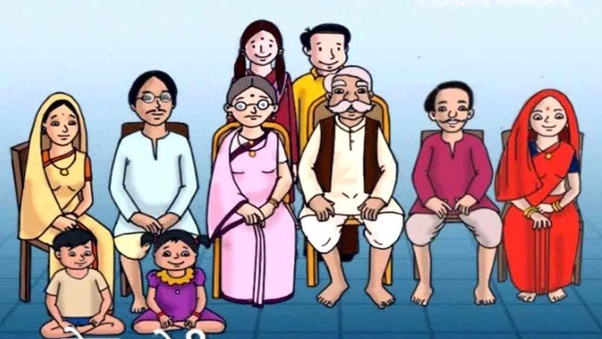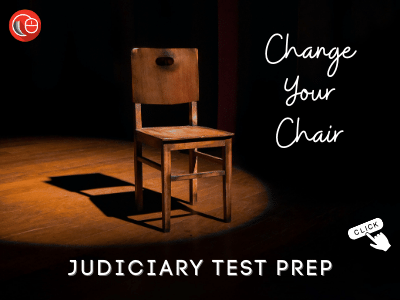“This article is written by Jasmine Madaan, from Vivekananda Institute of Professional Studies (VIPS). This is an exhaustive article that describes the difference between Joint Hindu Family and a Coparcenary.”
Table of Contents
Introduction
The concept of Joint Hindu Family and Coparcenary is believed to be one of the cornerstones of the Hindu family law. It is extremely important to understand the features and differences between the two. This article describes what is a Joint Hindu Family and a Coparcenary under Mitakshara and Dayabhaga school of law, respectively, and then highlights the difference between the two along with a tabular description.
Mitakshara School of Law
It is one of the Hindu law schools that govern the succession of property in a Hindu family. Joint Hindu Family is an important concept under Mitakshara school under which the son, grandson and grandson’s son have a right by birth in the family property. It is further divided into 4 schools:
- The Benaras school;
- The Mithila school;
- The Maharashtra school;
- The Dravida school.
What is a Joint Hindu Family?
Joint Hindu Family is an inevitable and fundamental concept of the Hindu family law which in present-day is governed by the Hindu Succession Act, 1956. It is a normal condition of Hindu society. For a Hindu, it is a never-ending process, if in one generation it is brought to an end by the means of a partition, it comes back into existence in the next generation automatically. This rule gives support to the presumption that every Hindu family is a Joint Hindu family.
It is presumed that the family continues to be a joint family if it is joint in affairs of food, worship, and estate as observed in Rukhmabai v. Lala LaxmiNarayan; Rajagopal v Padmini. However, if a family is not joint in food and worship, i.e. even if they live separately, they constitute a Joint Hindu family provided they are joint in the estate. A Joint Hindu Family is neither a corporation nor a juristic person as they do not have a separate legal entity from that of its members as held in the case of Chhotey Lal and Ors. v. Jhandey Lal and Anr. It is a unit and is represented by the Karta of the family in all matters.

Composition
It consists of all the family members i.e. all the male members descended lineally up to any generation from a common ancestor together with their mothers, wives, widows, and unmarried daughters as observed in Surjit Lal Chhabda v. CIT. A daughter remains a part of her parents’ joint family, till the time she is unmarried. Once she gets married, she becomes a part of her husband’s Joint Hindu family.
If the daughter is deserted by her husband or becomes a widow, and returns to her father’s home permanently, she again becomes a part of that Joint Hindu family. Her children, however, remain a part of their father’s Joint Hindu family and do not become a part of the mother’s father’s Joint Hindu family. It was observed in the case of Gur Narain Das v. Gur Tahal Das that even an illegitimate son of a male descendant will be a part of his Joint Hindu family.
Beginning
It is pertinent to note that without a common ancestor Joint Hindu Family cannot be brought into existence. The presence of a common ancestor is a necessity for its beginning, but it is not necessary for its continuation i.e. the death of the common ancestor does not bring the Joint Hindu Family to an end. Upper links of the family are removed and lower links are added by marriage, birth, or adoption of the child in the marriage. This process continues as long as it does not become extinct. The members are bound by the fundamental principle of Sapinda relationship(belonging to the same ancestors, up to three and five lines of ascent from mother’s and father’s side, respectively) or family relationship.
Exit
The status of being a part of the Joint Hindu Family can be ceased in the following cases:
- By conversion to another religion or faith.
- By marriage to a non-Hindu(a person who is not Hindu as per Section 2 of the Hindu Marriage Act, 1955 which include a Muslim, Jew, Parsi or Christian by religion).
- By being given in adoption to a third party by the competent parents.
- By marriage of a daughter.
Important points
-
Position when there is only one male member in the family
In such a case the Joint Hindu family can still continue to function as the requirement of a male member is essential to start a Joint Hindu family and not for its continuance. It is not necessary to have at least two or more male members in the family to make it a Hindu Undivided family as a taxable entry. In the case of CIT v. Gomedalli Lakshminarayan it was held that even if the coparcenary does not exist in a family still that family continues to be a Hindu Undivided family.
-
Position when there are only female members (widow)
On the death of the sole male member, a joint Hindu family can continue to exist at the instance of already existing female members of the family. The term ‘continuation’ is different from starting or forming a joint family for the first time.
In the case of CIT v. Sarwan Kumar, the Supreme Court held that on the death of the last surviving male member, the other family members can continue to be a Joint Hindu family, even if they are not coparceners. The death of the male member is a self declaratory fact that there was an existence of male members in the joint family.
The court in the case of Attorney General of Ceylon v. Arunachalam Chettiar held that as per the law, so long as the female members of the family can add a male member to the family, a joint family does not come to an end.
Illustration:
- If A and B are brothers, C and D are wives of A and B respectively. Four of them together constitute a Joint Hindu family.
- If A and B die in a car accident then also, C and D can continue the Joint Hindu family provided, if either of them is already pregnant with the child of their husband or if they decide to adopt a male child.
Therefore, the test laid down is the potential of the female members to add a male member to the family either by natural means or lawful means as observed in Ashok Kumar Ratanchand v. CIT also.
-
Position when there are only daughters
Before the Hindu Adoption and Maintenance Act, 1956:
As discussed above that female members should have the capacity to add a male member in order to continue the Joint Hindu family. However, before 1956 daughters did not have the capacity to add a male member to her father’s joint family. The reason being that she could give birth to a legitimate child only after her marriage, and once she is married she becomes a part of her husband’s joint family and ceases to be a part of her father’s joint family.
After the Hindu Adoption and Maintenance Act, 1956
The Act gave power and permission to even a single woman to adopt a child. As per law, the status of an adopted child is the same as that of a child born into the family. Now, the woman could add a male member to her father’s Joint Hindu family without getting married. Therefore, an adopted child can be maintained by a single parent also.
After the 2005 amendment in the Hindu Succession Act, 1956
The amendment to the Act gave the right to a daughter to be a coparcener and now she can not only continue the Joint Hindu family but also constitute one with her father and brothers.
-
Position when there are only husband and wife
As there is a chance of adding a male member or basically a coparcener to the family by the couple, therefore they can constitute a Joint Hindu Family. There is a conflict in the judicial opinion on the question, whether husband and wife can form a joint family as per revenue statutes to take advantage of the exemption from tax as Hindu Undivided Family?
In the case of T. Srinivasan v. CIT, a partition took place in a Joint Hindu Family and the son took his share. For a certain while, he filed his returns as an individual until he got married. The question came into consideration when his wife was pregnant. It was held that only when the son is born, he becomes a member of the joint family.
In Surjit Lal’s case, it was held that the property which a coparcener obtains on the partition does not become for all times his individual property. If he is married he has an obligation to maintain his wife. If he has children then he is obligated to maintain his unmarried daughter and minor son. If a son is born he is entitled to a share in ancestral property. The court also held that the absence of a history of jointness between a man and his ancestors should not cause any problem in forming a Joint Hindu family with his wife.
It is the duty of the husband to maintain his wife as per Section 18 of the Hindu Adoption and Maintenance Act, 1956. The wife can, therefore, claim maintenance from the husband’s separate as well as ancestral property.
Thus the individual while receiving property on partition and getting married with no son or no children at all is considered as the Karta of the Joint Hindu Family.
To conclude a husband and a wife can constitute a Joint Hindu Family as well as Hindu Undivided Family.
What is Coparcenary?
The term ‘Coparcenary’ is used in matters related to Hindu Succession law. It is a narrower part or institution within a Joint Hindu Family, It deals with property related matters only i.e. the coparcenary property of a Joint Hindu Family
Composition
Unlike the Joint Hindu Family, coparcenary consists of all male lineal descendants up to three generations from the last holder of the property. Senior-most member is called the ‘last holder’ and from him up to three generations i.e. son, son’s son, and son’s son’s son constitute the coparcenary. There can be any number of male members in a particular generation.
Every member of the coparcenary is related to each other either by blood or valid adoption. It is a laid rule that no person can become a coparcener by marriage or any agreement to become a coparcener as coparcenary is a creation of law as observed in Sudarshan v. Narasimhulu. As per the Hindu Succession Act, 1956 no female member could be a coparcener but it was later altered with 2005’s amendment to the Act. Now, Section 29A of the Hindu Succession Act provides that a female is entitled to receive the same share in the coparcenary property as that of a son.
Beginning
Like a Joint Hindu Family, the presence of the senior-most male member is compulsory to start a coparcenary. The presence of at least two male members is necessary to constitute and even to continue a coparcenary. Just like a Joint Hindu Family, in a coparcenary, upper links are being removed subsequently, and lower links are added to the chain, provided there are at least two male members(coparceners) maintaining the status of a joint family.
A male member within the three generations from the last holder of the property(total four generations) becomes a coparcener right from his birth i.e. it is a ‘right by birth’ in the family property.
End
Coparcenary comes to an end either by the partition or by the death of all the male members of the family or the sole surviving coparcener.
Important Points
- The existence of property is a must in a coparcenary. If someone acquires his father’s property during his lifetime, after his death that particular property will be inherited by his son as Joint family property and this will be continued further.
- Before 2005, only males had the right to be a coparcener.
- An insane son is also a coparcener but does not have a right to ask for partition.
- Rule of survivorship applies to the coparcenary property i.e. when a coparcener dies his interest in the joint family property devolves on the surviving coparceners and not by the rule of succession. Since there is a continuous addition and deletion of coparceners by birth and death respectively, therefore there is a fluctuation of interest in the property of every coparcener.
Illustration: ‘A’ has two sons- B and C.
- In the case of a partition, they will get one-third share each.
- If ‘B’ dies, then the share of ‘A’ and ‘C’ will enlarge and become one-half each as the share of ‘B’ also gets divided between the rest of the Coparceners.
- Now, if two more sons ‘D’ and ‘E’ are born to ‘A’ and if now partition takes place among A, C, D, and E, then each will get one-fourth share of the property.
- Just like there can be more than one coparcenary within different branches of a family, likewise, there can be coparcenary within a coparcenary.
Illustration:
- A has three sons- B, C, and D. A is the last holder of the property.
- If C and D have their separate property and one son is born to C and two sons to D. The sons of D (and C) will get birthright not just in the ancestral property headed by A but also in the sub-coparcenary that is formed between sons of C and D.
In the case of Moro Vishwanath v. Ganesh Vithal, the court held that a partition can be demanded only by one more than four degrees from the acquirer but it cannot be demanded by a person who is at one more than four degrees removed from the last owner. The reason behind this is that the coparcenary extends to four degrees from the last owner. The Court explained the concept with certain illustrations, which are as follows:
- Illustration 1:
- If a family consists of A, the original owner and his lineal descendants are- B (son), C (grandson), D (great-grandson). D has two sons- E and F, E further has two sons.
- If B and C die for instance, in a car accident. Neither E and F are still not entitled to ask for partition nor can they sue their father for the partition.
- Now, if A also dies they can ask for partition as now they lie within the category of coparceners.
- Illustration 2:
- If a family consists of A, the original owner and his lineal descendants are- B (son), C (grandson). C has two sons- D1 and D2, D1 further has two sons- E and F. E also has a son G.
- If B and C die for instance, in a car accident. After them D1 also dies, then the two sons of D1(E and F) and a grandson(G) cannot ask for partition because the property is inherited by D2 alone.
Point of differences
Illustration:
- If A, B, C, D, E, F, G, H and I are lineal male descendants with ‘A’ being the last holder of the family property.
- People of all the 8 generations together constitute a Joint Hindu Family whereas till the time A is alive from him up to three generations, a coparcenary is formed i.e. A, B, C, and D are coparceners.
| Joint Hindu Family | Coparcenary |
| It is a wider institution as it includes all-male lineal descendants from a common ancestor, it also includes their wives and unmarried daughters. | It is a narrower institution as it includes only three male lineal descendants from the last holder of the property. |
| There is no limitation of generations, it can extend to any number of generations. | There is a four-generation rule i.e. males within four generations from, and inclusive of the eldest member of the family. |
| Every family member can be part of it including females and illegitimate sons. | Only males can be coparceners and after 2005’s amendment daughters were given the right to be a coparcener. |
| Even after the death of all coparceners or male members, it does not ipso facto mean that Joint Hindu Family has come to an end. As long as a female member has the right to add a new male member to the family, it continues. | Coparcenary comes to an end when all the male members or coparceners die. |
| In a Joint Hindu Family, the existence of property is not essential. | In a Coparcenary, the existence of property is very essential. |
| The rights and interests of the joint family members are determined by the Law of Succession. | Rule of survivorship is followed and not the law of succession as on the death of a coparcener, his interest in the property devolves on surviving coparceners. |
| Members have limited rights, viz, of maintenance and marriage expenses of the unmarried daughters. | The rights of coparceners are very wide, viz, Right to partition, and right to alienate. Each coparcener is the owner of the entire property but no one can set up an individual title to any part of the property. |
| Every Joint Hindu Family is not a coparcenary. | Every coparcenary is a Joint Hindu Family. |
Dayabhaga School of Law
The concept of Joint Undivided Family remains the same in Dayabhaga school of law as that in Mitakshara school of law except for the fact that in Dayabhaga school, son, grandson and grandson’s son do not have right by birth in the family property. In a real sense, there is no concept of Coparcenary in Dayabhaga law school as it does not recognize the rule of survivorship i.e. there is an absence of right by birth in the property of the joint family. It does not recognize any difference between ancestral and separate property. Both the separate and ancestral property is divided as per the law of succession. Sons cannot ask for partition of the joint family property. On the death of the coparcener, his share does not pass to surviving coparceners but goes to heirs.
Situation after the 2005 Amendment
The amendment to the Hindu Succession Act of 1956 in the year 2005 was seen as a remarkable step towards eradication of gender inequalities and bringing gender and social parity. The most significant amendment was the abolition of Doctrine of Survivorship and providing the right to daughters whether married or unmarried to be a coparcener and have a right by birth in the joint family property. Section 6(1) of the Hindu Succession Act, 2005 provides that in a daughter of a coparcener brought up as per Mitakshara school shall have:-
- Right by birth to become a coparcener in her own right in the same way as a son. Marital status of a daughter does not matter.
- Same rights as that of a son in the coparcenary property.
- Same liabilities as of that of a son with respect to the coparcenary property.
- Any sort of reference to Mitakshara coparcener shall also include a reference to the daughter as well.
Conclusion
The concepts of Hindu law were earlier based on the mindset favoring the patriarchal society including the concept of coparcenary, Karta, etc. Coparcenary is considered as a sub-part of the main concept of the Joint Hindu family. With the advent of time and especially with the enforcement of the Hindu Succession Act, 2005, the legislature tried to bring the women at par and to an extent overcome the patriarchal approach.
References
- https://www.srdlawnotes.com/2017/01/distinction-between-joint-family-and.html
- https://www.legalbites.in/joint-hindu-family/
- https://indiankanoon.org/doc/1922953/
- https://dullbonline.wordpress.com/2017/07/31/moro-vishvanath-v-ganesh-vithal-1873-57-bom-h-c-reports-444/
- http://www.shareyouressays.com/knowledge/difference-between-coparcenary-and-joint-family-explained/117747
- https://www.toppr.com/guides/legal-aptitude/family-law-II/joint-family-and-coparcenary
- https://indiankanoon.org/doc/1291956/
Students of Lawsikho courses regularly produce writing assignments and work on practical exercises as a part of their coursework and develop themselves in real-life practical skills.
LawSikho has created a telegram group for exchanging legal knowledge, referrals, and various opportunities. You can click on this link and join:
Follow us on Instagram and subscribe to our YouTube channel for more amazing legal content.
 Serato DJ Crack 2025Serato DJ PRO Crack
Serato DJ Crack 2025Serato DJ PRO Crack












 Allow notifications
Allow notifications



